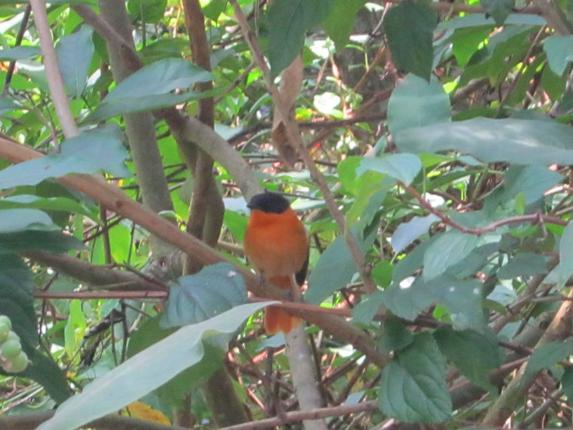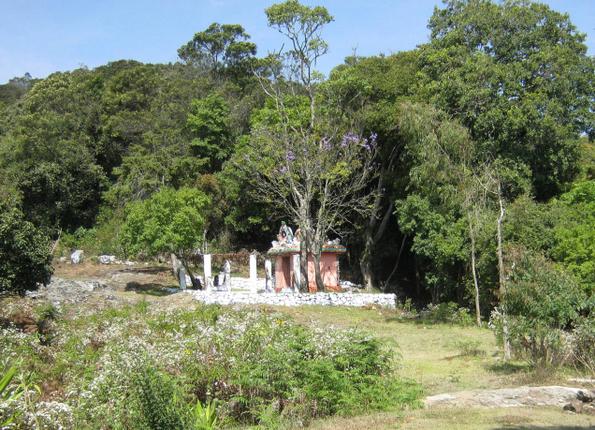Orange flycatcher / by Special Arrangement / The Hindu
The temple at Honatty / by Special Arrangement / The Hindu
Serenity, birds and a reminder of mortality is what Pankaja Srinivasan get at this middle-of-nowhere temple in Honatty
At Donnington Circle in Kotagiri, we fuel up with sweet tea, (the way only chai kadais in the hill stations know how to make) and pakodas at ‘Adengappa’. M. Sivalingam is turning this way and that to get a signal on his mobile. He is fixing up with someone at Honatty who will take us to a small 200-year-old temple, hidden from tourists. Sivalingam is a sought after guide for serious birders, and knows the Nilgiris like the back of his hand.
It is sunny but the air is crisply cool and there are trees everywhere. So different from Coimbatore, where we began our journey in the morning, where there are dug up roads, uprooted trees, dust and heat.
We take the Keezh Kotagiri Road towards Kodanad. Sivalingam explains how each area of the Nilgiris has a species specific to it. We listen to the Nilgiri Laughing Thrush. “You find a lot of them at Doddabetta. They come for the garbage,” he says, sadly. When we wax lyrical about the Nilgiris, he says there is no real reason to rejoice. “I remember trees laden with oranges, peaches, plums and pears. Visitors to the village would go back with baskets of fruits. There is not a single fruit tree in my village now,” he says.
We pass tea factories built by the British, patches of forests, then ominous patches of cleared land (for resorts to come up). Then, it is back into cool glades and unkempt roads, till we bump to a halt at a clearing near a village, Honatty. Seventy-year-old Madhan takes us to his temple. “My grandfather built it; so, it is more than 150 years old,” he says, and points upwards. Not to the heavens, but the path we have to take!
There are no steps, just rocks and loose mud underfoot, and bushes and trees to act as handrails. Just over half a kilometre, Sivalingam assures me. To my panic-stricken eyes, it looks like a vertical climb. But climb we must, because hidden, on the other end, is the temple. Madhan does this trip twice a day to light the temple lamp. I wheeze gratefully to a halt when Sivalingam points out splotches of scarlet rhododendrons that grow only in the Nilgiris and in the Himalayas. He plucks a berry and invites me to taste it. It is delicious. He points to the branches of a tree and says, “Malabar Giant Squirrel!” I try to spot it. All that green has confused my eyes, but a sudden orange streak, and there it is! Eating berries.
At last, level ground, and it takes my breath away. A clearing that is fenced in. We leave our footwear and step onto a carpet of grass. We can see the temple in the distance, but Madhan insists we sit down for a while. We do, just outside a circle of stones that encloses a jamun tree, at the base of which is a small stone. An ancient god, says Madhan. We sit in silence. Madhan’s grandfather cleared up a patch of dense forest and built a temple that was nothing more than a grass structure. His eyes fill with tears as he speaks of the hardships his grandfather faced, and the faith he reposed in God that kept him close to the temple.
He asks me how old I am and when I tell him, he says, “Oh, so more than half your life is behind you.” Chastened, I scramble up to pay my respects to Ranganathar. And, I am rewarded by another glimpse of a Malabar Giant Squirrel that takes my mind away from my mortality. Bears, gaurs and tigers are regular visitors here. They live in the dense forest that surrounds us. Madhan has encountered them often enough.
Madhan hopes his son will continue to look after the temple after him. No one comes here. But, he is delighted that just two years ago, he managed to make the temple pucca. If he lives long enough, he would like to have a small feast and invite the nearby villagers. But he too is worried about the shrinking forest cover and the water shortage.
Is Madhan’s temple worth documenting? May be not. No kings or famous people have patronised it. And 150 years old is not that ancient in our culture. But, it still stands only on an old man’s faith, because he thinks it is God’s will. There are no hundis, no priests. Just enormous calm and peace. Isn’t that what places of worship are meant to be?
We start our descent, Sivalingam nimbly, and I with more caution than grace. Climbing down is more difficult, I discover. But we stop every now and then. Sivalingam holds up his hand, asking me to hold still. He takes out his mobile phone and plays the call of a flycatcher. And to my utter delight, out hops a bird, head cocked to one side looking for its mate — the Black and Orange Fly Catcher!
Getting there
From Donnington in Kotagiri, take the Keezh Kotagiri road towards Kodanad. After about four km at the S. Kaikatti Junction take the Solurmattam route towards Honatty.
What not to miss
Sit at the temple clearing and listen to birdsong. Not too far is the Kodanad View Point. And, Ooty and Coonoor are just a drive away.
source: http://www.TheHindu.com / Home> Features> Friday Review > History & Culture / by Pankaja Srinivasan / March 21st, 2013

